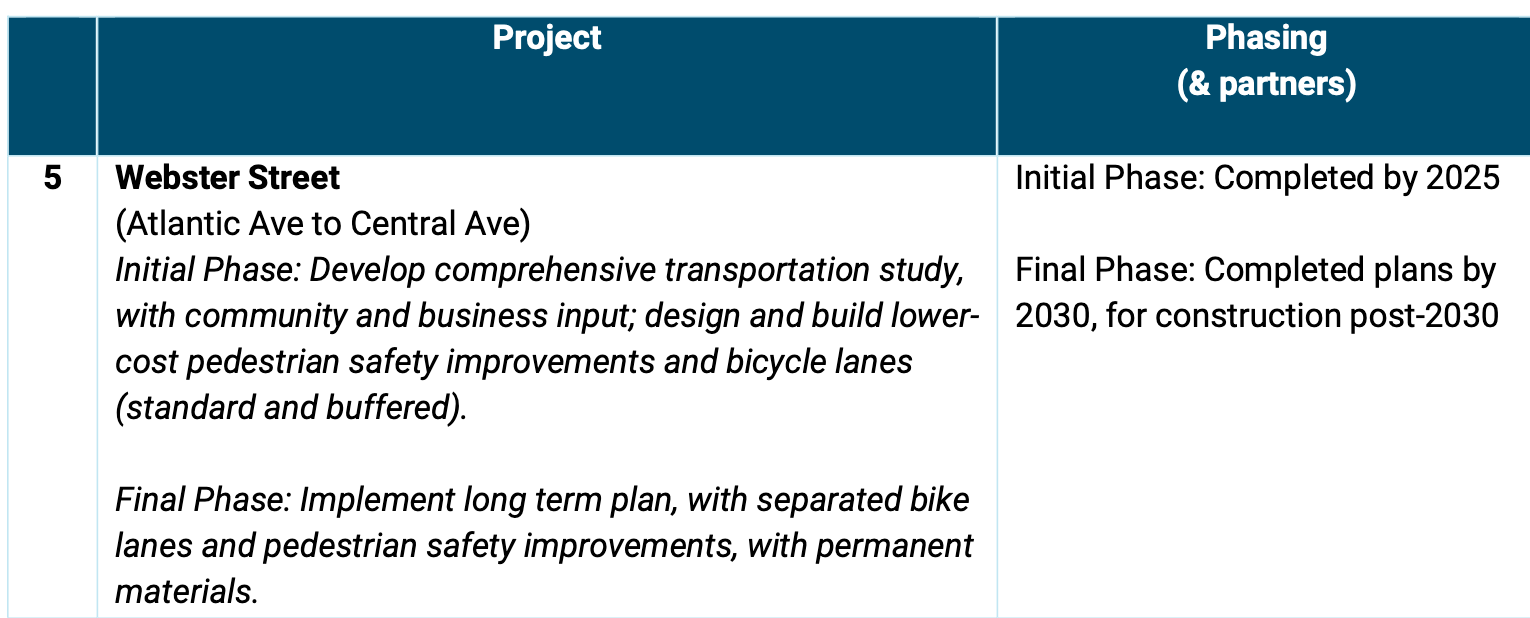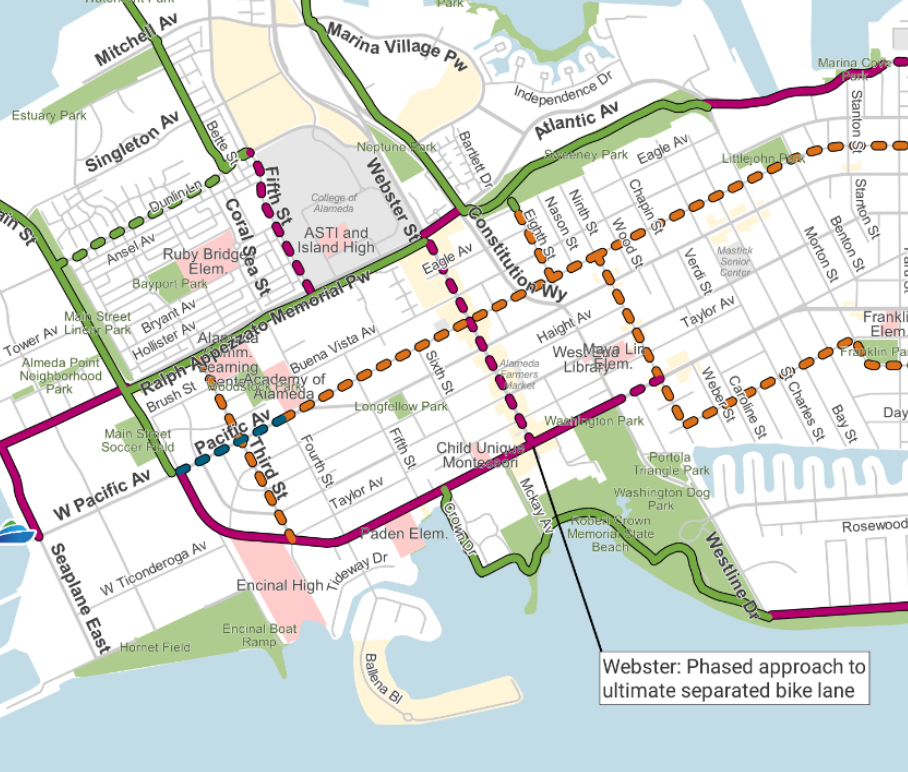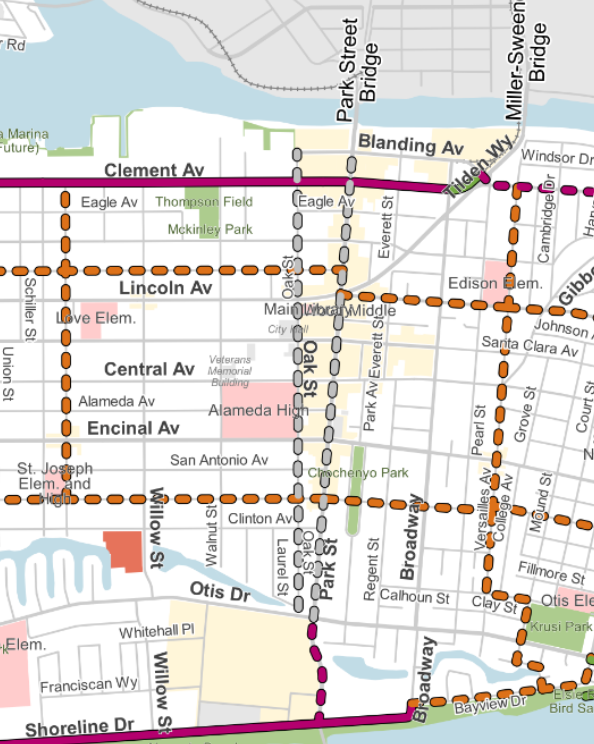On our way back from celebrating our preschooler's graduation, we drove down Webster Street at about 7:30 p.m. on Friday evening.
"That's what I'm talking about!," I said aloud – somewhat unexpectedly loudly – while gesticulating toward some illegally parked cars. I guess I wasn't so much talking with my spouse or my kids as continuing aloud a series of thought from my own prior blog posts about Alameda's "Commercial Streets" program.
Two cars were parked in a row and another was parked a short distance ahead. They each had flashing red lights on and were blocking the newly painted unprotected Class II bike lanes along the core of the Webster Street business district.
So, bike lanes for cyclists sometimes... and free parking for DoorDash delivery drivers whenever they want it.
Unfortunately, this parking-in-the-bike-lane is probably also a preview of what will soon happen on Park Street when that is re-striped later this year.
An iterative approach
Instead of focusing too much on the shortcomings of the current phase of the Commercial Streets program, let's keep the iterative approach going. Let's make incremental progress year-by-year on both Webster Street and Park Street.
When my spouse and I want to defer things that our kids ask for — like smartphones — we say they have to wait until after 2030. In other words, a long time!
I started writing this as a much more negative blog post, but then deleted most of that draft. The Active Transportation Plan has been adopted, and so at this point it's probably more useful to keep going with year-by-year progress than it is to get hung up about any of the specific target end-dates.
What's next for Webster Street?
Per the Active Transportation Plan, Webster Street is supposed to get bicycle lanes all the way from Central Ave up to Atlantic Ave/Ralph Appezzato Memorial Parkway by 2025:

This will connect the existing Cross Alameda Trail down to Central Ave — which will soon have safe cycling facilities of its own.
There are currently no safe and comfortable north/south connections for cyclists on the West End of Alameda. The unprotected bike lanes recently added to Webster St. don't fulfill the safety criteria — but they are a step in the right direction. It's important to continue them north as soon as possible to provide a connection to the Cross Alameda Trail:

What's next for Park Street?
It's somewhat soon to ask what's next? when the new striping hasn't yet been painted on Park Street.
I do think it's safe — and unfortunate — to predict that the unprotected bike lanes on Park Street will be used often by DoorDash delivery drivers.
But we don't yet know how parking pricing and policy improvements on and around Park Street will help to improve the situation with double-parked cars. The city does have more "levers" around Park Street to encourage drivers to do the right thing — to park in a designated on-street spot or an off-street parking lot or garage, rather than leave their car wherever they see open pavement.
While the question around Webster is when the bike facilities will be extended north, the question around Park is whether bike facilities will be just on Park Street, just on Oak Street, or a combination (a paired "couplet" of one-way protected bike lanes):


Can we actually keep to our plans?
Alameda's Active Transportation Plan was adopted in December of 2022 — and already in the intervening time, some of the projects have longer than expected or have been de-prioritized (like the Neighborhood Greenways).
I'm being somewhat intentionally naive in quoting plans and dates that have already slipped.
But the goals are still good, and the plans are still worthwhile. If more staff resources are needed to implement the adopted plans, then the City Manager and City Council should allocate those resources. If more funding is needed, then let's get creative about all the many local, county, state and federal sources that can be tapped and combined.
Could property-owners step up?
The Active Transportation Plan seems to assume most local projects will be led by the city itself (with the exception of the outdated auto-centric projects that Caltrans builds on the right-of-way it owns across Alameda). But what if property owners were more involve? In the case of the business districts, it's the owners of the land that will gain literal value from improvements to surrounding sidewalks, cycling facilities, and the overall appearance of the "streetscape."
Alameda's two business districts each have a "business improvement association" that charges modest fees to businesses to provide services (marketing, cleaning, organizing events). At the May 7 City Council meeting, the two business improvements are delivering their annual reports to the City Council.
These sorts of business improvement districts are limited in only being able to get membership dues from businesses within their boundaries — they don't get money from the actual owners of those properties.
If one or both of these business districts turned into a "Property and Business Improvement District" (PBID), then they could potentially collect money from property owners and pursue larger projects. For example, the owners of the buildings in downtown Alameda could tax themselves to rebuild attractive sidewalks, extended permanent dining areas, comfortable cycling facilities to attract customers of all ages by bike, better lighting for evening shoppers,... and even one of those quaint little gateway arches.
Or the city itself could create an "Enhanced Infrastructure Financing District" around downtown Alameda and put an incremental portion of property taxes from commercial buildings toward rebuilding an attractive, safe, and comfortable streetscape.
The temporary plaza at Alameda Ave and Park Street is a fine place to eat outside — I'm glad it's been created. But the temporary materials are fading and the place feels incomplete. Imagine if the surrounding property owners pooled their resources to actually build it out as a real permanent plaza: a level surface of attractive pavers, tables and benches, some planters, maybe a water fountain, or maybe even a little stage for musical performances? And imagine if this space could be accessed by foot, by car, and by safe and comfortable biking routes along Park and/or Oak.
The current phase of the Commercial Streets program isn't, unfortunately, going to realize a vision like that. The next step probably won't either. Still, it's worth iterating year by year to improve Alameda's two business districts.
What collaborations could be started if we weren't so busy with distractions?
In addition to being intentionally naive about the project dates in the Alameda Active Transportation Plan, I'm also being intentionally naive about the City's capacity to explore "post-Redevelopment" funding schemes to rebuild the streetscapes of downtown Alameda or Webster Street.
The City already has its hands full trying to modernize and lease out commercial properties at Alameda Point. City staff already have their hands full holding open houses about whether to ban animal testing in city-owned properties. City staff are also being intentionally "DDOS'ed" by a small number of individuals making extremely large Public Records Act requests.
What if instead of these distractions, a couple city staffers had time to organize a bus tour around the Bay Area of other business districts with high quality outdoor spaces and bike/ped access — and they invited along key stakeholders from local businesses and local property owners?
That's what I'm talking about and that's what I'm thinking about when I see drivers illegally parked in the newly painted bike lanes on Webster Street.